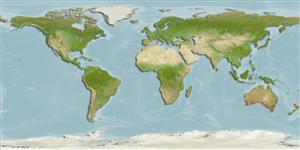Common names from other countries
分类 / Names
俗名 | 同种异名 | Catalog of Fishes(属, 种) | ITIS | CoL | WoRMS | Cloffa
Environment: milieu / climate zone / depth range / distribution range
生态学
海洋; 半咸淡水; 深度上下限 0 - 20 m (Ref. 6390). 溫帶; 27°S - 44°S
Eastern Indian Ocean: Endemic to Australian temperate waters (Murchison River, Kalbarri in Western Australia to Eden, New South Wales, including Tasmania).
東印度洋: 澳洲的溫帶水域的特有種.(Murchison 河, 在澳洲西部到伊甸園,新南威爾斯的卡爾巴瑞, 包括塔斯梅尼亞)
Length at first maturity / 大小 / 重量 / 年龄
Maturity: Lm ?, range 25 - ? cm
Max length : 52.0 cm SL 雄鱼/尚未辨别雌雄; (Ref. 10988); 最大体重: 600.00 g (Ref. 6390); 最大年龄: 10 年 (Ref. 27011)
背棘 (总数): 0; 背的软条 (总数): 15-18; 臀棘 0; 臀鳍软条: 17 - 20; 脊椎骨: 55 - 61. Gill rakers usually 33 or less on the first arch and usually 26 or less on the second arch. Relatively shorter upper and lower jaw, especially at larger sizes.
鳃耙通常在第一个弓上的 33 以内与通常在第二个弓上的 26 以内。 相当比较短的上颌与下颌, 尤其较大时。
Found inshore in surface waters of estuaries, bays, inlets and gulfs to a depth of about 20 m (Ref. 9563). In the South Australian gulfs, southern sea garfish may be found in deeper waters during the colder months (Ref. 27008). Generally herbivorous, seagrasses and algal filaments comprise about 75% of their food (Refs. 26551, 27013). Form schools, generally found near the surface at night and close to the bottom over seagrass beds during the day (Ref. 6390). Post-larvae or young fish less than 1-year-old live in estuaries from March to July then move to inshore marine waters, remaining there for up to 2 years (Ref. 27012).
在河口,海湾,小水湾与海湾到深度大约 20 公尺的水表面中发现于岸边了。 (参考文献 9563) 在南方中澳大利亚的海湾, 南方的海洋长嘴硬鳞鱼在比较寒冷的数个月期间可能被发现于较深的水域.(参考文献 27008) 通常食草的, 海草与海藻的丝状突起包含大约 75% 的他们的食物 (参考文献。 26551,27013). 形成鱼群, 通常发现晚上接近水表面处而且接近在海草床上的底部在白天期间.(参考文献 6390) 生活于河口从三月到七月的后期仔鱼或幼鱼少于 1 岁然后移动到被逗留在哪里超过 2 年的近海海洋。 (参考文献 27012)
Life cycle and mating behavior
成熟度 | 繁殖 | 产卵场 | 卵 | 孕卵数 | 仔鱼
Viviparous (Ref. 205).東印度洋: 澳洲的溫帶水域的特有種.(Murchison 河, 在澳洲西部到伊甸園,新南威爾斯的卡爾巴瑞, 包括塔斯梅尼亞)
Collette, B.B., 1974. The garfishes (Hemiramphidae) of Australia and New Zealand. Records of the Australian Museum 29(2):11-105. (Ref. 10988)
CITES (Ref. 128078)
Not Evaluated
人类利用
渔业: 商业性; 诱饵: usually
更多信息
参考文献养殖养殖信息品种遗传学Electrophoreses遗传率疾病加工Mass conversion
合作者照片Stamps, Coins Misc.声音神经毒速度泳型鳃区Otoliths脑重体重比眼睛色素
工具
特别资料
下载 XML
网络资源
Estimates based on models
Preferred temperature (Ref.
115969): 14.3 - 22.3, mean 17.6 (based on 324 cells).
Phylogenetic diversity index (Ref.
82804): PD
50 = 0.5000 [Uniqueness, from 0.5 = low to 2.0 = high].
Bayesian length-weight: a=0.00257 (0.00115 - 0.00574), b=3.09 (2.91 - 3.27), in cm Total Length, based on LWR estimates for this Genus-body shape (Ref.
93245).
营养阶层 (Ref.
69278): 2.7 ±0.27 se; based on food items.
回复力 (Ref.
120179): 中等的, 族群倍增时间最少 1.4 - 4.4年 (K=0.51-0.77; tm=2-3; tmax=10).
Fishing Vulnerability (Ref.
59153): Low to moderate vulnerability (28 of 100).
